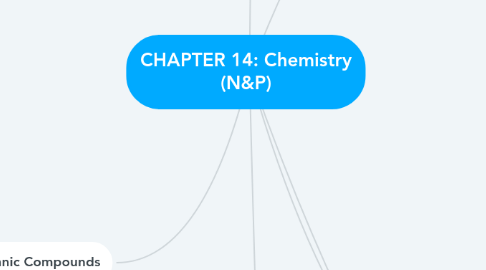
1. Organic Compounds
1.1. Big 4:
1.1.1. carbon
1.1.2. hydrogen
1.1.3. nitrogen
1.1.4. oxygen
1.2. Hydrocarbons: Carbon with H- attached
1.2.1. saturated
1.2.1.1. alkanes (only single bonds)
1.2.1.1.1. burn readily, react with halogens
1.2.1.1.2. methane
1.2.1.1.3. ethane: most common
1.2.1.1.4. KNOW THESE!!
1.2.2. unsaturated
1.2.2.1. alkenes (double bonds)
1.2.2.1.1. hexene (6 carbon, double bond)
1.2.2.2. alkynes (triple bonds)
1.2.3. alkyls: hydrogens omitted
1.2.3.1. reactive, bond to functional groups
1.3. Radicals
1.4. Isomers
1.4.1. Stereoisomers
1.4.1.1. identical formulas, different spatial arrangement (enflurane, isoflurane): different halogen substitutions, same chemical formula and atomic weight, diff structures and characteristics (vapor pressure, MAC, blood gas solubility)
1.4.1.1.1. optical isomers: bend light due to group attached to carbon
1.4.1.1.2. geometrical isomers: 2 carbons with double bond - no axial rotation
1.4.2. Structural Isomers
1.4.2.1. differ in chemical and physical properties
1.5. Functional Groups: atoms bonded together specifically defining chemical and physical properties
1.5.1. Alcohols (ROH), very polar, dissolves other polar molecules
1.5.2. Phenols (ROH)
1.5.2.1. Simple phenol is polar
1.5.2.2. Complex phenol NOT water soluble (propofol)
1.5.3. C=O: carbonyl group - polar
1.5.3.1. key component in aldehydes, ketones, carboxylic acids, esters, amides
1.5.4. R or R': attached hydrogen or hydrocarbon side chain
1.5.5. 2 parts
1.5.5.1. carbon backbone
1.5.5.1.1. relatively inert
1.5.5.2. one or more functional groups
1.5.5.2.1. define properties of compound
1.5.6. Organic Compounds
1.5.6.1. Halogens: F, Cl, Br, I
1.5.6.1.1. R-X (x = any halogen atom)
1.5.6.1.2. halogen compounds: most inhaled anesthetics derived from straight chain hydrocarbons or ether compounds
1.5.6.2. Ethers (ROR): highly flammable
1.5.6.2.1. organic oxides, 2 radical groups, 1 Oxygen (functional group)
1.5.6.2.2. diethyl ether
1.5.6.2.3. replaced with nonexplosive halogenated ethers
1.5.6.3. Esters (R-COO-R)
1.5.6.3.1. form by interacting alcohol with acid
1.5.6.3.2. anesthetic compounds: esters of para-aminobenzoic acid
1.5.6.4. Amides (-CONH2)
1.5.6.4.1. related to carboxylic acids - urea
1.5.6.4.2. class of local anesthetics
1.5.6.5. Amines: R-NH2
1.5.6.5.1. derivatives of ammonia, functional group - Nitrogen
1.5.6.5.2. primary, secondary, tertiary (depending on how many Hydrogen atoms replaced by radical)
1.5.6.5.3. Physiological active amines
1.5.6.6. Aromatic Compounds: most common formation - benzene ring C6Hc
1.5.6.6.1. replacing hydrogen with radical creates new compund
2. Elements necessary for human life
2.1. Electrical balance of body fluids
2.1.1. Sodium
2.1.2. Potassium
2.1.3. Chlorine
2.1.4. Phosphorus (neutrality of fluids)
2.2. Bones/teeth/growth
2.2.1. Calcium (strengthens bones, clotting, muscle contraction)
2.2.2. Magnesium (enzymes, nerve/muscle action, present in bones/teeth)
2.2.3. Copper (strengthens bones, enzyme action, formation of hemoglobin)
2.2.4. Manganese ( present in bone forming enzymes, fat and carb metabolism)
2.2.5. Zinc (necessary for normal growth)
2.2.6. Flourine (reduces cavities)
2.3. Other
2.3.1. Sulfur (protein structure)
2.3.2. Chromium (increase insulin effectiveness)
2.3.3. Cobalt (part of B12)
2.3.4. Iodine (thyroid function)
2.3.5. Iron (ion on hemoglobin - attach O2)
2.3.6. Molybdenum (activity of certain enzymes)
3. Bond Breaking
3.1. Break - Energy consumed; Formed - energy released
3.1.1. ATP conversion to ADP (energy consumed)
3.2. Enthalpy: total amount of energy possessed by system
4. Atoms
4.1. Atomic Structure
4.1.1. Nucleus
4.1.1.1. neutron (neutral)
4.1.1.2. protons (+)
4.1.2. Electrons (-)
4.1.2.1. Electron Configuration
4.1.2.1.1. Electron shells K(2), L(8), M(18), N(32), O(32), P(18), Q(8)
4.1.2.1.2. Subshells: s(2), p(6), d(10), f(14), g(18)
4.1.2.1.3. 2-8-8 configuration
4.1.2.2. Octet: most stable with 8 electrons in outer shell (or 2 for He)
4.1.2.2.1. noble gases
4.1.2.3. Ions: +/- electron.
4.1.2.3.1. Anion (-)
4.1.2.3.2. Cation (+)
4.1.2.4. Isotopes: same protons, different neutrons, different mass
4.2. Dalton's Atomic Theory
4.3. Elements
4.3.1. identity/atomic number - protons
4.3.1.1. Periodic Table
4.3.1.1.1. KNOW THESE!
4.3.2. atomic weight: protons+neutrons
4.3.3. pure substance
4.4. Compounds
4.4.1. pure substance, 2 or more elements
4.4.1.1. fixed ratio of atoms
4.4.2. Mixtures: combination of pure substances
5. Molecule: tightly bound group of atoms act as unit
5.1. Chemical Bonds
5.1.1. Covalent
5.1.1.1. Physical sharing of electrons, stronger
5.1.1.1.1. octet rule
5.1.1.2. Compounds composed of non-metals tend to be molecular
5.1.2. Electrostatic: "opposites attract"
5.1.2.1. Ion-Ion
5.1.2.1.1. strongest, not directional, occur anywhere along outer shell, high melting and boiling (NaCl)
5.1.2.2. Ion-Dipole
5.1.2.2.1. uneven distribution of e- (water)
5.1.2.2.2. occurs between ion and polar molecule
5.1.2.3. Dipole-Dipole
5.1.2.3.1. water: weak bonds, polar sides bond with ions - good solvent
5.1.2.3.2. attraction between opposite partial charges of polar molecues
5.1.2.4. Hydrogen bonding
5.1.2.4.1. dipolar interaction, stronger than dipole-dipole
5.1.2.4.2. most important - holds water together in liquid state
5.1.2.5. London forces
5.1.2.5.1. instant dipole when e- unevenly distributed
5.1.3. Bonding Representations
5.1.3.1. Lewis (electron dot structure)
5.1.3.2. Valence Shell Electron Pair Repulsion
5.1.4. KNOW!!
6. Matter
6.1. gas: no volume, no shape, expand infinitely
6.1.1. steam
6.2. liquid: have volume, assume container shape
6.2.1. water
6.3. solid: have volume, shape, cannot be compressed
6.3.1. ice
